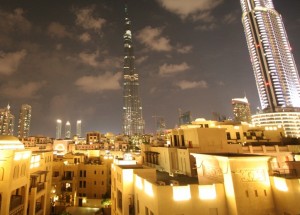By Karen Mazurkewich, Financial Post www.financialpost.com
It started as a design concept. When Montreal-based gsmprjct was hired to conceive and construct the multimedia elements for the viewing platform of the world’s tallest building, the Burj Khalifa in Dubai, it seized on the idea of installing state-of-the-art LCD touchscreen telescopes. But there was a hitch: No such device existed.

So Yves Mayrand, president of gsmprjct°creation, turned to a sister company, gsmprjct°technologie, for help. The telescope, with its Internet-connected digital video monitor, was so well received that gsmprjct is spinning out a separate company to lease them to other sites such as the CN Tower in Toronto and the John Hancock Center in Chicago.
Most small businesses sell product. In Montreal, there is a cluster of companies that sell ideas. Three years ago, Montreal was designated a UNESCO City of Design — one of only three cities worldwide to receive that honour. Part of its reputation has been built on the backs of world-class theatrical producers Cirque du Soleil and Ex Machina, the multimedia company founded by theatrical director Robert Lepage.
The growing international reputation of these two firms has led to a mushrooming of creative firms in the city, focusing on high-end exhibition and lighting.
“Relative to our size, Montreal is hyperactive in design,” says Mr. Mayrand, whose firm not only created the multimedia concept for the Burj Khalifa tower in Dubai, but was also the creative behind the $24-million makeover of the National Museum of Singapore. He attributes the international accolades and contracts to the synergy that exists among the creative class.
“Montreal has an incredible talent pool … and we share a lot,” says Mr. Mayrand, referring to how people tend to move between firms. There is only one degree of separation among many of these internationally ranked firms. gsmprjct°creation is working with Cirque du Soleil on the design of the Canadian Pavilion for the Shanghai Expo in 2010.
It also collaborated with Lightemotion, the Montrealbased lighting design firm working on the National Museum of Singapore, which in turn calls on custom-lighting manufacturers such as Montreal-based Sistemalux Group to supply unique fixtures for tricky concepts.
“The secret of our success right now is that I have a very eclectic team, some come from scenic art backgrounds, we have people who’ve worked at museum exhibitions and graphic designers,” says Francois Roupinian, president of Lightemotion.
Mr. Roupinian, a lighting designer, started his career in theatre but when race car driver Jacques Villeneuve saw Ceci est une Sphere, produced by Mr. Roupinian for the Montreal en Lumiere festival, he introduced him to Dupuis Le Tourneux Architects. Mr. Villeneuve, who was building the Newtown Restaurant and Bar in Montreal, wanted Mr. Roupinian’s “light touch.”
Mr. Roupinian, whose firm pulls in about $1-million in revenue a year, says his clients are now almost entirely international. The city that fostered his talent “doesn’t have big enough budgets” to keep him busy, he says. Mr. Roupinian and his 12 man team, have applied their artistic vision to create the atmospheric, and energy efficient, LED lighting for the Auckland Museum in New Zealand, and the interior lighting for the Revel Casino in Atlantic City, which is under construction.
“We ask for samples, and manufacturers and suppliers are eager to lend them to us because we don’t take kick-backs and commissions,” Mr. Roupinian says. They design custom fixtures, but after the job is done the manufacturer can sell the idea to another client.
Mr. Mayrand of gmsprjct is pursuing a different business model. With average revenue
of $10-million a year, he hopes to take the company to the next level by leveraging its design expertise to generate revenue.
Rolling out their line of digital telescopes is the first phase of its new strategic plan. Mr. Mayrand says gsmprjct°technologie will build and install them into top tourist attractions for a share of the revenues.
Next up is his plan to launch travelling exhibitions. The company is in final talks to license the brand of a large U.S. conglomerate. The goal is to finance, build and install exhibitions around the world for a share of the revenue host institutions get from ticket sales.
By increasing its geographic footprint and finding revenue-sharing models, gsmprjct has managed to triple revenue and staff in the past 10 years. But if the new strategy to convert ideas into revenue-sharing projects works, he expects revenue to skyrocket.
The secret to his success? “We don’t just package something to make it pretty and make awards, we are interested in conveying that content … and that’s rare in this business,” Mr. Mayrand notes.












